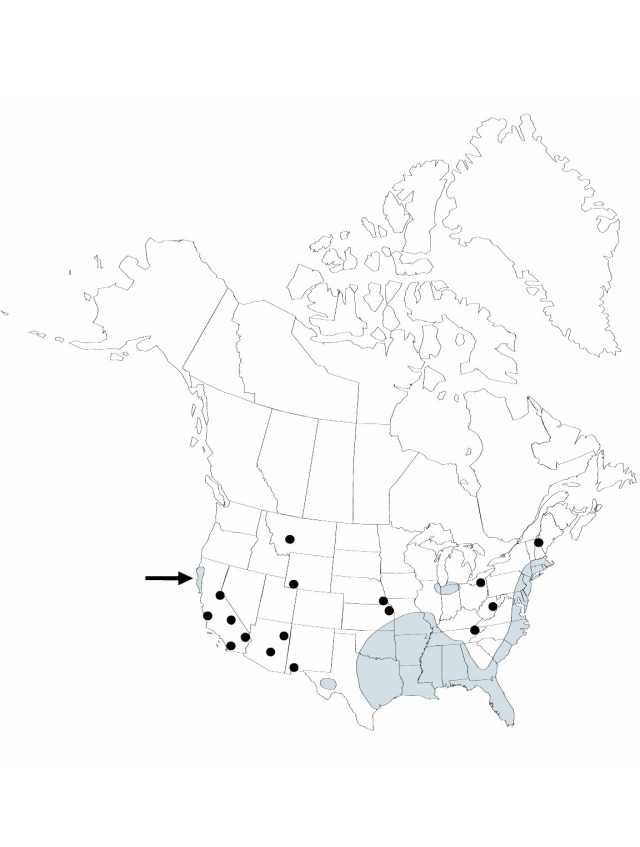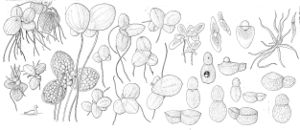Difference between revisions of "Lemna valdiviana"
Linnaea 33:239. 1864.
FNA>Volume Importer |
FNA>Volume Importer |
||
| Line 11: | Line 11: | ||
|name=Lemna cyclostasa | |name=Lemna cyclostasa | ||
|authority=(Elliott) C. H. Thompson | |authority=(Elliott) C. H. Thompson | ||
| − | }}{{Treatment/ID/Synonym | + | }} {{Treatment/ID/Synonym |
|name=Lemna torreyi | |name=Lemna torreyi | ||
|authority=Austin | |authority=Austin | ||
| Line 29: | Line 29: | ||
|elevation=0–2000 m | |elevation=0–2000 m | ||
|distribution=Ala.;Ariz.;Ark.;Calif.;Conn.;D.C.;Fla.;Ga.;Ill.;Ind.;Kans.;Ky.;La.;Md.;Mass.;Mich.;Miss.;Mo.;Mont.;Nebr.;N.H.;N.J.;N.Mex.;N.Y.;N.C.;Ohio;Okla.;Pa.;R.I.;S.C.;Tenn.;Tex.;Va.;W.Va.;Wyo.;Mexico;West Indies (Bermuda);Central America;South America. | |distribution=Ala.;Ariz.;Ark.;Calif.;Conn.;D.C.;Fla.;Ga.;Ill.;Ind.;Kans.;Ky.;La.;Md.;Mass.;Mich.;Miss.;Mo.;Mont.;Nebr.;N.H.;N.J.;N.Mex.;N.Y.;N.C.;Ohio;Okla.;Pa.;R.I.;S.C.;Tenn.;Tex.;Va.;W.Va.;Wyo.;Mexico;West Indies (Bermuda);Central America;South America. | ||
| − | |discussion=<p>I know of no specimens of Lemna valdiviana from Delaware, but the species is to be expected there.</p> | + | |discussion=<p>I know of no specimens of <i>Lemna valdiviana</i> from Delaware, but the species is to be expected there.</p> |
|tables= | |tables= | ||
|references= | |references= | ||
| Line 53: | Line 53: | ||
|publication year=1864 | |publication year=1864 | ||
|special status= | |special status= | ||
| − | |source xml=https://jpend@bitbucket.org/aafc-mbb/fna-data-curation.git/src/ | + | |source xml=https://jpend@bitbucket.org/aafc-mbb/fna-data-curation.git/src/8f726806613d60c220dc4493de13607dd3150896/coarse_grained_fna_xml/V22/V22_455.xml |
|genus=Lemna | |genus=Lemna | ||
|species=Lemna valdiviana | |species=Lemna valdiviana | ||
Revision as of 15:58, 18 September 2019
Roots to 1.5 cm, tip rounded to pointed; sheath not winged. Stipes white, small, often decaying. Fronds floating or (rarely) submersed, 1 or 2–few, coherent in groups, ovate to lanceolate, flat, thin, 1–5 mm, 1.3–3 times as long as wide, margins entire; veins 1, mostly prominent, longer than extension of air spaces, or running through at least 3/4 of distance between node and apex; with or without small papillae along midline of upper surface; anthocyanin absent; largest air spaces much shorter than 0.3 mm; turions absent. Flowers: ovaries 1-ovulate, utricular scale open on 1 side. Fruits 1–1.35 mm, not winged. Seeds with 15–29 distinct ribs. 2n = 40, 42.
Phenology: Flowering (very rare) spring–fall.
Habitat: Mesotrophic, quiet waters in temperate to tropical regions
Elevation: 0–2000 m
Distribution

Ala., Ariz., Ark., Calif., Conn., D.C., Fla., Ga., Ill., Ind., Kans., Ky., La., Md., Mass., Mich., Miss., Mo., Mont., Nebr., N.H., N.J., N.Mex., N.Y., N.C., Ohio, Okla., Pa., R.I., S.C., Tenn., Tex., Va., W.Va., Wyo., Mexico, West Indies (Bermuda), Central America, South America.
Discussion
I know of no specimens of Lemna valdiviana from Delaware, but the species is to be expected there.
Selected References
None.
